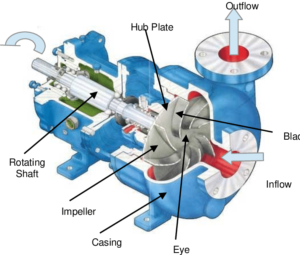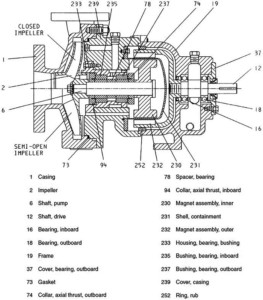There are essentially two types of centrifugal pumps: radial and axial. The primary difference between radial and axial centrifugal pumps is within their orientation. Radial centrifugal pumps work by allowing liquid to flow outward. The liquid is pressurized and then pushed out through a downstream pipe. Axial pumps, on the other hand, product fluid motion by using a lifting effect with their impeller vanes.
Not every sealless centrifugal magnetic drive pump will work well for every application. In this article, we will provide five tips for choosing a centrifugal magnetic drive pump that operates well in your specific context.
Tip #1: Know What Material You’re Dealing With
Mechanically sealed pumps feature an impeller connected to a motor with a rotating shaft that extends through the pump’s casing. Because the shaft requires clearance, manufacturers must use seals to prevent leakage. Over time, these seals will inevitably degrade, requiring maintenance before the pump can be returned to safe operation.

Diagram from ResearchGate
Mag-drive preclude the need for seals because the shaft isn’t physically linked to casing. Similar to a mechanically sealed pump, these sealless pumps have fluid flow through a casing that contains an impeller. But the connection to the shaft occurs via a magnet, which removes the seals and much of the potential for leaks. For this reason, mag-drive pumps are often selected when an end-use application requires the transfer or utilization of potentially dangerous or reactive liquid.

Diagram from Pumps & Systems
The removal of seals, though, doesn’t eliminate the possibility of leakage if purchasers fail to take into account the nature of the pumped liquid and the material out of which the pump is constructed. Some liquids are strongly alkaline, such as sodium hydroxide, potassium hydroxide, and sodium hypochlorite, while others like nitric acid, formaldehyde, and ferric chloride are acidic. Failure to match a nonreactive pump material with the pumped liquid can lead to machine damage and/or failure. Read our article “Chemical Ratings For Various Pumps And Materials” to learn how to select an appropriate pump material.
Tip #2: Calculate Flow and Pressure When Properly Sizing a Pump
In the pumping process, the liquid must travel through an array of pipes, and this network creates resistance (i.e., friction loss) that the pump must overcome. That resistance is called “total dynamic head” or, more colloquially, simply “head.” The head will vary based on the liquid’s specific gravity, viscosity, and temperature, as well as the vertical rise of the liquid. One can determine the total dynamic head by adding the static head (defined as the distance between the central part of a pump’s impeller and the discharge line’s highest point) and the friction loss (defined as the pipe’s internal resistance and written as pounds per square inch or PSI).
Total dynamic head will vary according to the total length of the pipe system and the volume per minute of the pumped liquid. This can be used to create a chart demonstrating the linear relationship between the variables, and manufacturers of centrifugal pumps provide just such a chart, which is known as a pump performance curve. By using a curve for a particular pump, you can determine if it’s the right size for your end-use application.
To learn more about calculating head, read our article “How to Calculate Total Dynamic Head for an Industrial Pump.” Additionally, you can read more about proper pump sizing in the American Institute of Chemical Engineers article “Pump Sizing: Bridging the Gap Between Theory and Practice.”
Tip #3: Understand That Centrifugal Magnetic Drive Pumps Aren’t Designed for Solids
While some centrifugal pumps are designed to pump solids, they require certain design specifications in order to function correctly. For example, their impellers are often either flexible to prevent jamming or stainless-steel impellers that can resist abrasives. They also require ample clearances to reduce operational interruptions or damages.
These are attributes that mag-drive pumps do not have. Sealless, magnetic-drive pumps require tight tolerances around their bearings, and the presence of solid matter can interfere with the magnet’s ability to connect the impeller to the shaft. Industry periodical Processing Magazine has stated that the most robust mag-drive pumps can only handle 5 percent solids with sizes up to 200 microns. For most mag-drive pumps, the maximum tolerated solids limit is 1.5 percent and 70 microns.
Tip #4: Determine the Risk of Dry Running
An interruption of liquid flow can prove disastrous when operating a mag-drive pump. This is because magnetic centrifugal pumps have small clearances and rely on the pumped material to provide lubrication. When the pumped liquid isn’t present, components such as bearings touch, generating friction and quickly causing damage.
Pumps & Systems discussed how dry running caused catastrophic damage to silicon carbide (SiC) magnetic sealless centrifugal pumps, saying, “If the SiC surfaces touch during operation, the components can break in a short time (depending on several factors). This does not mean the pump stops operating immediately. The broken SiC pieces may still support the shaft well enough to allow rotation of the pump rotor. Broken SiC can be detected by increased vibration and often a power increase. The condition of the pump will only get worse if operation is continued.” While other pump materials may be able to tolerate dry running for longer periods, the amount of time that can pass before damage occurs can typically be measured in seconds or minutes.
Tip #5: Realize That Operating Temperature is Paramount to Avoiding Overheating
The manuals for all March Pump products specify the maximum liquid temperatures that should be used in our pumps for open air or submerged applications. Operating above these temperatures can lead to multiple problems, including damage to the pump and damage to the engine driving the pump. Overheating is particularly problematic for a mag-drive pump’s magnets. Higher temperatures may cause the binders holding the magnets in place to warp or break, may negatively impact the force of the magnets, or (in certain extreme cases) may cause the magnets to permanently lose their magnetism should operating temperatures reach the Curie point. (The Curie point is a material-specific temperature that permanently changes that material’s magnetic properties.)
While transferring material that exceed your pump’s operating temperature recommendations is the prime cause of overheating, dry running a pump may also lead to elevating temperatures. In cases where liquid was reintroduced to the pump after an extended period of dry running, explosions have occurred, causing significant damage.
Centrifugal magnetic drive pumps excel at numerous kinds of applications, but users must exercise care when selecting them for specific uses. Browse our wide selection of pumps to see which will work best for your end-use scenario.